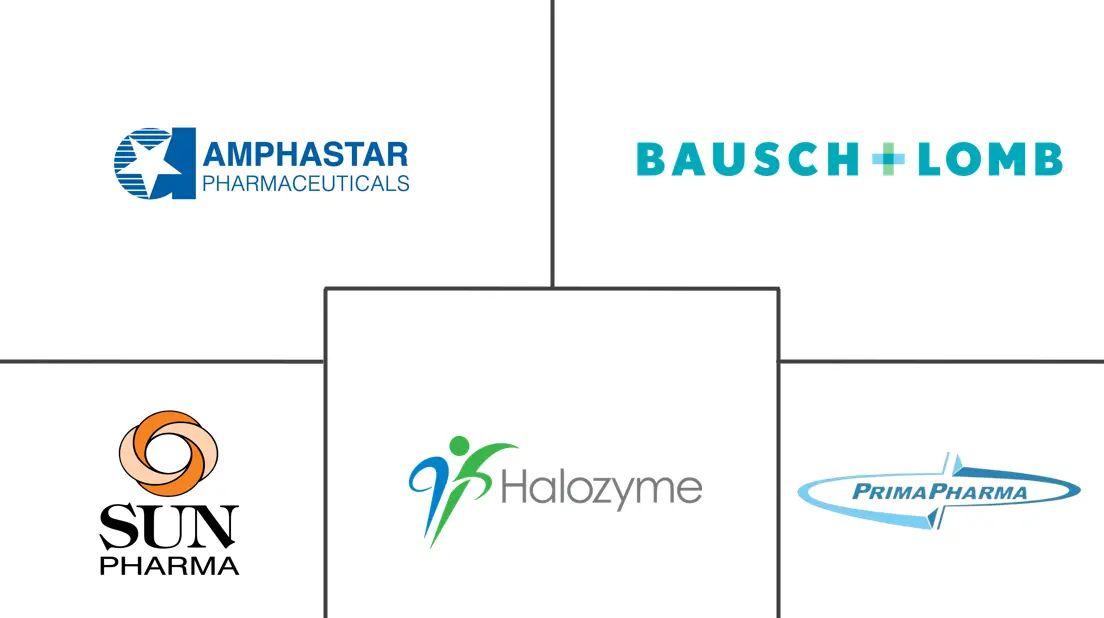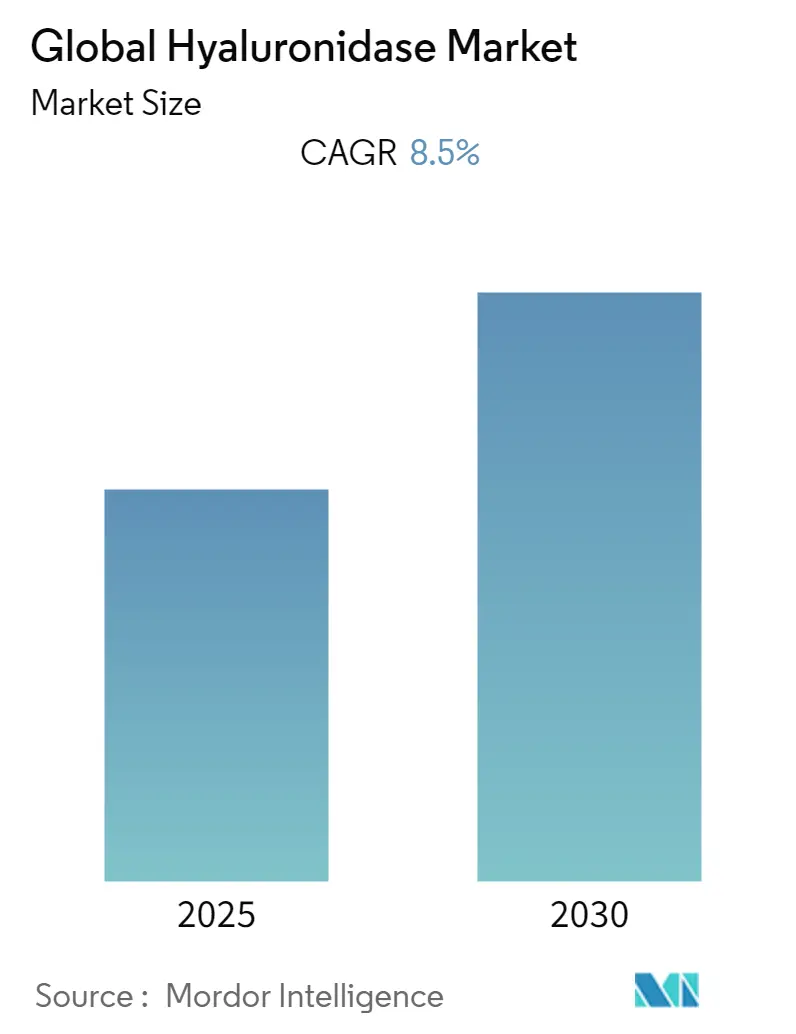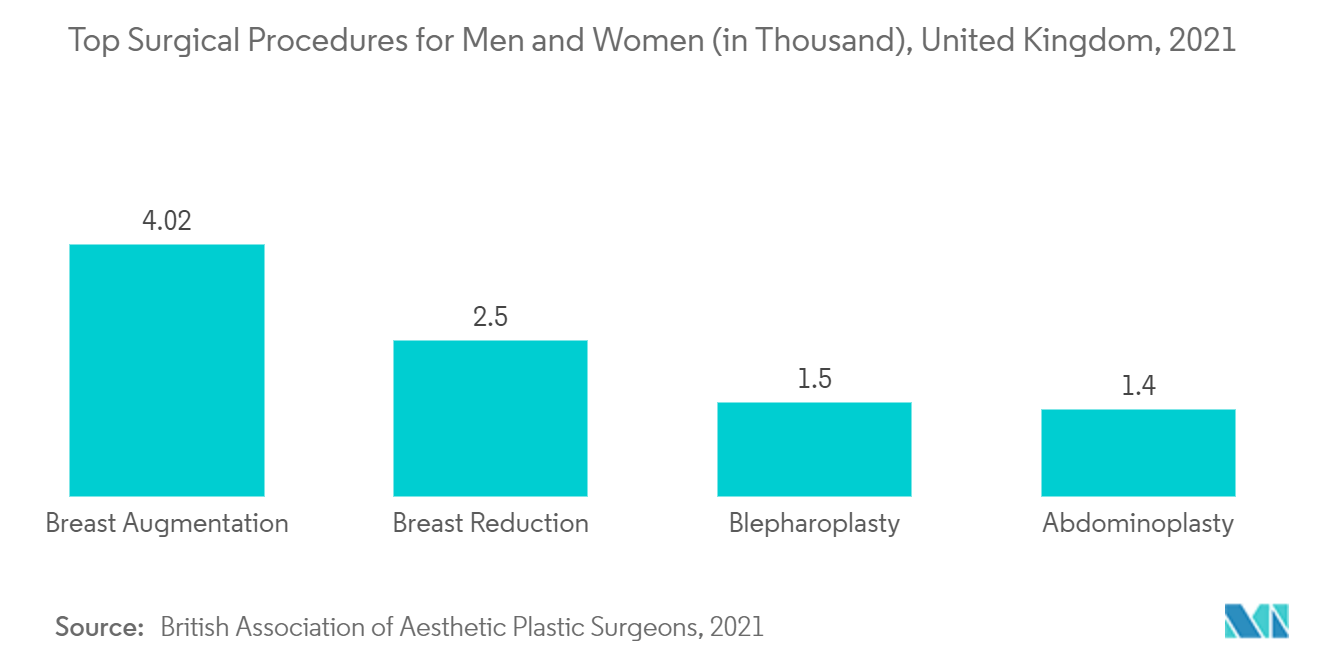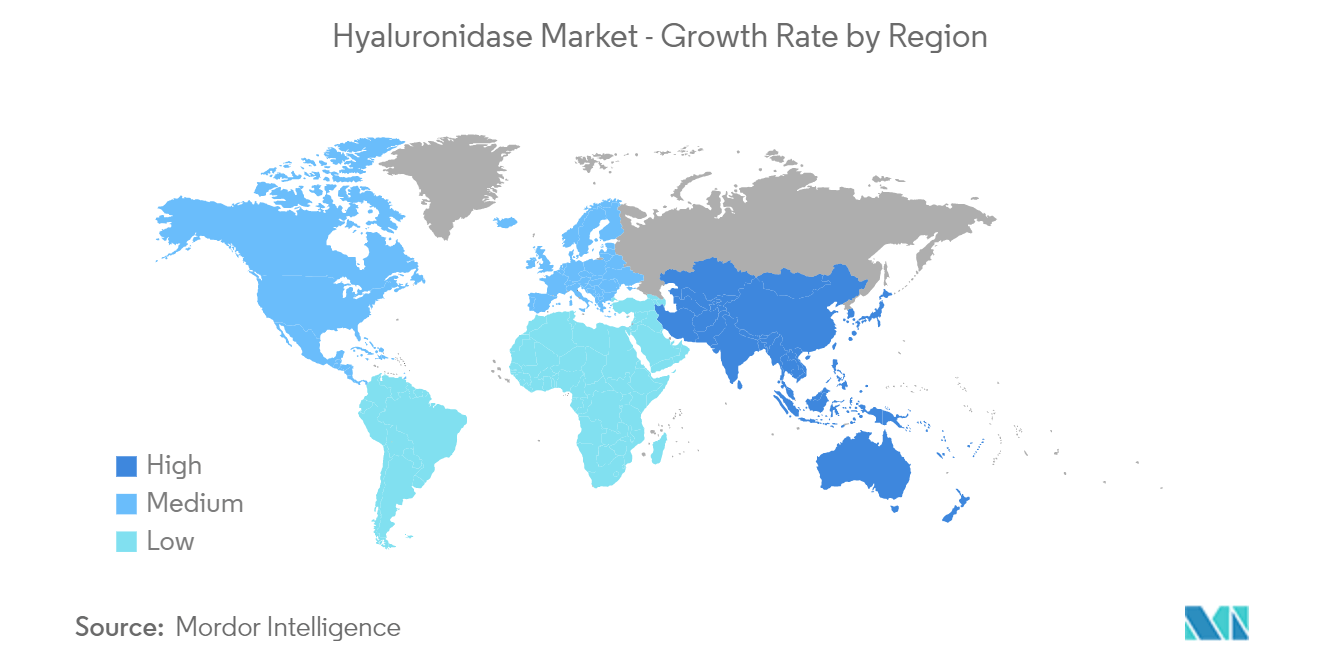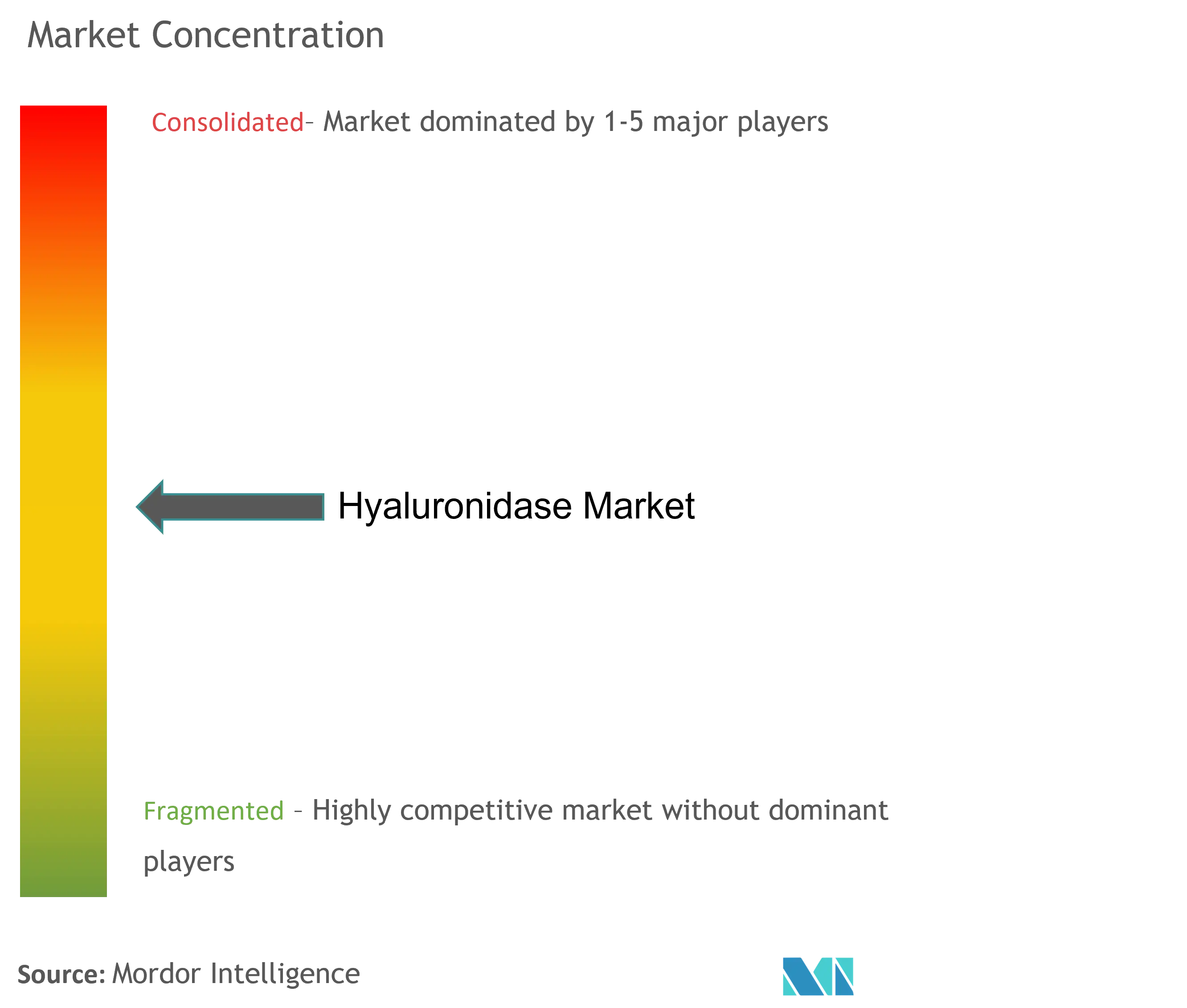Hyaluronidase Market Size
Hyaluronidase Market Analysis
The Global Hyaluronidase Market is expected to register a CAGR of 8.5% during the forecast period.
The COVID-19 pandemic had a significant impact on the hyaluronidase market. For instance, a 2021 article by the British Association of Aesthetic Plastic Surgeons (BAAPS) stated that there was a 27% decrease in cosmetic surgical procedures in the previous year.Since most of the aesthetic surgical procedures utilize hyaluronidase, a decrease in aesthetic surgical procedures decreased the demand for hyaluronidase and thereby impacted the growth of the studied market. However, in the current scenario, it is anticipated that the resumption of surgical procedures due to the reduction of COVID-19 cases may increase the demand for hyaluronidase compared to the beginning of the pandemic. Thus, the studied market is expected to witness significant growth over the forecast period.
The studied market is growing because more and more correction procedures are using hyaluronidase and more and more people want minimally invasive cosmetic treatments.For example, a December 2022 article in the journal Aesthetic Plastic Surgery said that hyaluronidase therapy can fix fillers that were injected too much and also help dissolve subcutaneous nodules.Dermatologists can use Hyaluronidase to correct and reverse the effects of failed hyaluronic acid-based filler treatments.Thus, due to these benefits, the demand for hyaluronidase is constantly increasing, thereby driving the growth of the studied market.
The market is also growing because more and more people want cosmetic treatments that don't require a lot of surgery.For example, the American Society of Plastic Surgeons (ASPS) reported in February 2022 that 13,281,235 minimally invasive cosmetic procedures were done in the United States in 2020. Botulinum toxin remained the most popular procedure with 4.4 million procedures, followed by soft tissue filler (3.4 million) and laser skin resurfacing (997,245).The source also reported that the total minimally invasive cosmetic procedures performed on males and females in 2020 were 820,123 and 10,429,962, respectively. Thus, the adoption of minimally invasive procedures is increasing the demand for hyaluronidase.
Furthermore, there has been a surge in demand for cosmetic procedures worldwide in 2021. For instance, a survey conducted in 2021 by the Menarini Group, an Italian pharmaceutical company, among 100 dermatologists and plastic surgeons across India revealed that 65% of the respondents agreed that a facelift is the most sought-after facial aesthetic procedure in India, and 37% of the respondents have observed an increased demand for aesthetic procedures since the onset of the global COVID-19 pandemic, with the desire to look good on social media. Thus, there has been a rise in awareness among people about aesthetic procedures, which is increasing the demand for hyaluronidase and thereby driving the growth of the studied market.
So, the market is expected to grow a lot over the next few years because hyaluronidase is being used more and more in corrective procedures and because people want less invasive cosmetic treatments. But the bad effects of hyaluronidase could slow the growth of the market that was studied.
Hyaluronidase Market Trends
Animal Derived Hyaluronidase Segment is Expected to Witness Significant Growth Over the Forecast Period.
Most of the approved and sold brands of hyaluronidase come from animal sources. This is why animal-based hyaluronidase has a high market share. Bovine and porcine are some of the most widely used animal sources. Hydase (PrimaPharma), Vitrase (Bausch & Lomb Incorporated), and Amphadase (Amphastar Pharmaceuticals, Inc.) are some of the brands manufactured by manufacturers.
Also, there have been a lot of new products on the animal-derived hyaluronidase market, which has helped this segment grow.For example, in August 2021, Mesoestectic started selling a line of moisturizing solutions that contain hyaluronic acid to keep the skin hydrated.Thus, such developments are driving the growth of this segment.
Also, the fact that animal-based hyaluronidase is better than synthetic types is likely to help the studied segment grow. In the United States, more than 107,000 dermal filler surgeries are done each year, according to an article published by the NCBI in April 2021. So, a high number of dermal filler surgeries are likely to increase the need for hyaluronidase from animals, which will help this segment grow.
Therefore, the advantages of animal-based hyaluronidase and the fact that the majority of products contain animal-based hyaluronidase are driving this segment's growth.
North America is Expected to Witness Significant Growth Over the Forecast Period.
North America is expected to have a big share of the global hyaluronidase market because it has a lot of big companies that make these products, a lot of people who use advanced treatments, and a lot of dermatology clinics that prescribe these treatments. The fact that healthcare costs are rising and there is a well-established healthcare infrastructure is also very beneficial to the expansion of the regional market as a whole.
The study market is growing because more and more people are getting cosmetic surgery.For example, the Aesthetic Society said in January 2022 that in the United States, surgical procedures went up by 54% and non-surgical procedures went up by 44% in 2021. The source also said that in the United States in 2021, there would be 3,651,223 neurotoxin procedures, 1,857,339 dermal filler procedures, and 1,390,149 skin treatment procedures.So, the high number of non-surgical procedures done in the United States is increasing the demand for hyaluronidase and driving the growth of the studied market in the region.
In a similar vein, an article by Aesthetic Plastic Surgery from September 2021 claimed that mastopexy procedures were adaptable and increasing in popularity in Mexico.During the next few years, the increase in these kinds of procedures is likely to help the market grow.
Also in March 2022, Argenx SE, a global immunology company that works to improve the lives of people with severe autoimmune diseases, reported positive topline data from the Phase 3 ADAPT-SC study testing subcutaneous (SC) efgartigimod (1000 mg efgartigimod-PH20) as a treatment for generalized myasthenia gravis (gMG).Argenx submitted a biologics license application (BLA) to the USFDA. Thus, such applications of hyaluronidase in the treatment of various diseases are driving the growth of the market in the region.
As a result, the numerous applications for hyaluronidase and the prevalence of cosmetic procedures are driving the growth of the studied market in the area.
Hyaluronidase Industry Overview
The hyaluronidase market is moderately competitive and consists of a few major players. Some of the companies that are currently dominating the market are PrimaPharma, Inc., Amphastar Pharmaceuticals, Inc., Bausch & Lomb Incorporated, Halozyme, Inc., Sun Pharmaceutical Industries Ltd., Stemcell Technologies, Inc., The Cooper Companies, Inc., Shreya Life Sciences Pvt. Ltd., Valeant Pharmaceuticals, CBC Pharma, and Genomic Solutions.
Hyaluronidase Market Leaders
-
PrimaPharma, Inc
-
Amphastar Pharmaceuticals, Inc
-
Bausch & Lomb Incorporated
-
Halozyme, Inc.
-
Sun Pharmaceutical Industries Ltd
- *Disclaimer: Major Players sorted in no particular order
Hyaluronidase Market News
- December 2022: The Janssen Pharmaceutical Companies of Johnson & Johnson reported the successful results from a cohort of Phase 1b MajesTEC-2 studies of TECVAYLI in combination with DARZALEX FASPRO (daratumumab and hyaluronidase-fish) and lenalidomide for the treatment of relapsed or refractory multiple myeloma.
- July 2022: Takeda announced positive topline results from the phase 3 clinical trial evaluating HYQVIA (immune globulin infusion at 10% (human) with recombinant human hyaluronidase) for maintenance treatment of chronic inflammatory demyelinating polyradiculoneuropathy.
Hyaluronidase Industry Segmentation
Based on what the report is about, hyaluronidase is an enzyme that breaks down hyaluronic acid and makes connective tissues more permeable. These enzymes are widely used in aesthetic procedures. The hyaluronidase market is divided into three sections: type (animal-derived hyaluronidase, synthetic hyaluronidase), application (chemotherapy, in vitro fertilization, ophthalmology, dermatology, and other applications), and geography (North America, Europe, Asia-Pacific, the Middle East and Africa, and South America). The market report also covers the estimated market sizes and trends for 17 different countries across major regions globally. The report offers the value (in USD million) for the above segments.
| By Type | Animal-Derived Hyaluronidase | ||
| Synthetic Hyaluronidase | |||
| By Application | Chemotherapy | ||
| In Vitro Fertilization | |||
| Ophthalmology | |||
| Dermatology | |||
| Others Applications | |||
| Geography | North America | United States | |
| Canada | |||
| Mexico | |||
| Europe | Germany | ||
| United Kingdom | |||
| France | |||
| Italy | |||
| Spain | |||
| Rest of Europe | |||
| Asia-Pacific | China | ||
| Japan | |||
| India | |||
| Australia | |||
| South Korea | |||
| Rest of Asia-Pacific | |||
| Middle East and Africa | GCC | ||
| South Africa | |||
| Rest of Middle East and Africa | |||
| South America | Brazil | ||
| Argentina | |||
| Rest of South America | |||
| Animal-Derived Hyaluronidase |
| Synthetic Hyaluronidase |
| Chemotherapy |
| In Vitro Fertilization |
| Ophthalmology |
| Dermatology |
| Others Applications |
| North America | United States |
| Canada | |
| Mexico | |
| Europe | Germany |
| United Kingdom | |
| France | |
| Italy | |
| Spain | |
| Rest of Europe | |
| Asia-Pacific | China |
| Japan | |
| India | |
| Australia | |
| South Korea | |
| Rest of Asia-Pacific | |
| Middle East and Africa | GCC |
| South Africa | |
| Rest of Middle East and Africa | |
| South America | Brazil |
| Argentina | |
| Rest of South America |
Hyaluronidase Market Research FAQs
What is the current Global Hyaluronidase Market size?
The Global Hyaluronidase Market is projected to register a CAGR of 8.5% during the forecast period (2025-2030)
Who are the key players in Global Hyaluronidase Market?
PrimaPharma, Inc, Amphastar Pharmaceuticals, Inc, Bausch & Lomb Incorporated, Halozyme, Inc. and Sun Pharmaceutical Industries Ltd are the major companies operating in the Global Hyaluronidase Market.
Which is the fastest growing region in Global Hyaluronidase Market?
Asia-Pacific is estimated to grow at the highest CAGR over the forecast period (2025-2030).
Which region has the biggest share in Global Hyaluronidase Market?
In 2025, the North America accounts for the largest market share in Global Hyaluronidase Market.
What years does this Global Hyaluronidase Market cover?
The report covers the Global Hyaluronidase Market historical market size for years: 2019, 2020, 2021, 2022, 2023 and 2024. The report also forecasts the Global Hyaluronidase Market size for years: 2025, 2026, 2027, 2028, 2029 and 2030.
Our Best Selling Reports
Fencing Industry Report
Statistics for the 2025 Global Hyaluronidase market share, size and revenue growth rate, created by Mordor Intelligence™ Industry Reports. Global Hyaluronidase analysis includes a market forecast outlook for 2025 to 2030 and historical overview. Get a sample of this industry analysis as a free report PDF download.

